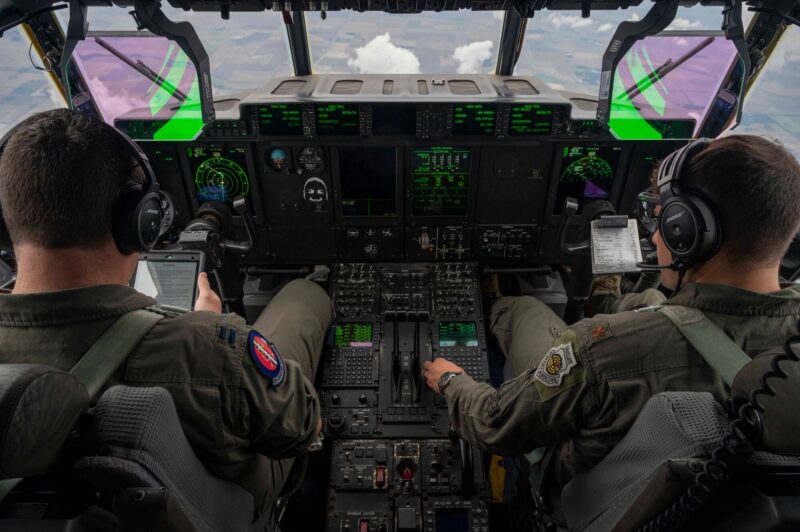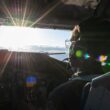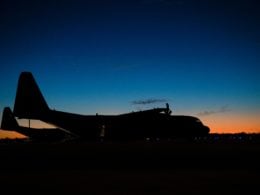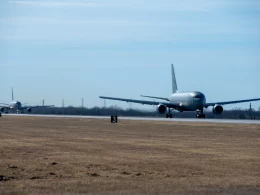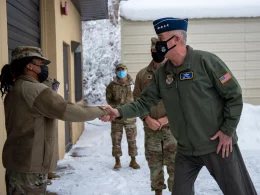LITTLE ROCK AIR FORCE BASE, Ark. — “Humble, approachable, credible;” this is the mantra that is engrained into pilots and loadmasters from the first day they step foot into the 29th Weapons Squadron.
Leading the charge is the 29th WPS cadre, who bear the responsibility of molding already experienced C-130 instructor pilots into Weapons Officers, capable of leading and instructing while effectively integrating multiple weapons systems across the land, air, space and cyber domains.
The 29th WPS and its two formal courses—Weapons Instructor Course (WIC) and Advanced Instructor Course (AIC) — serve as the bridge from the Herk community to the Air Force and Joint enterprises. Simply stated, both courses focus on how to effectively employ the C-130 mission as part of larger, integrated operations.
“Our pilots and loadmasters work side-by-side with students from 31 different aircraft and weapons systems—all of whom are on the same journey to be humble, approachable, and credible Weapons Officers,” said Lt. Col. Christopher Casler, 29th WPS commander.
Every six months, the 29th WPS is responsible for graduating an average of six to eight Weapons Officers and four Advanced Instructors. Throughout the course, students receive an average of 350 hours of graduate-level academics while simultaneously participating in demanding combat training missions.
“There’s a common saying that the WIC is a leadership course disguised as a tactics course, and I’ve found that to be absolutely true,” said Maj. Terry Wu, 29th WPS director of staff. “A student cannot graduate without the hard lessons learned from leadership failures during the course. Only through those trials and tribulations can students learn to adjust and refine themselves to become more effective leaders.”
The WIC and AIC both serve as top-tier training programs for instructor pilots and loadmasters, ultimately pulling students back to where they first received their initiation into the Herk community — here at Little Rock AFB, the “Home of Herk Nation.”
“All C-130J pilots and loadmasters start their journey at LRAFB, and those that choose to serve as Weapons Officers and Advanced Instructors culminate that training at the 29th WPS on the same flightline they started on,” Casler said. “Simply put, this is the most advanced training for C-130 pilots and loadmasters.”
Casler added that both the C-130J and C-130H syllabi are incorporated into the WIC, however, H-model pilots conduct their flightline training at Rosecrans Air National Guard Base, Mo.
Throughout the course, this process undergoes multiple evolutions in order for students to continuously refine their leadership capabilities even well after graduation.
Furthermore, weapons instructors are responsible for taking their knowledge and dispersing it throughout the C-130 community, fostering a more diverse, educated and unified core.
The same can be said for the cadre members, who are getting after Casler’s command priorities of graduating Tier 1 Weapons Officers and Advanced Instructors, leading the C-130 community and attacking tough problems.
“We are required to be the leader of leaders, and one of the methods to sustain that is to continue to hold ourselves to the same or higher standards of our students,” Wu said.
Wu added that being an instructor is similar to going through the WIC again with multiple iterations bundled into one, which allows them to continuously evolve and develop leadership characteristics.
“In order to provide the necessary training and instruction, our programs require the instructor cadre to be the best instructors in the force,” Casler said. “The USAF Weapons School standard is incredibly high, and our graduates are expected to be experts, leaders and critical thinkers. The only way our graduates reach that standard is through premier cadre that focuses on each individual every day of the course.”
However, the cadre do not shoulder this challenge alone.
Wu added that there is an incredible team of civilians and support staff who wear multiple hats to keep the squadron running. Many of the civilians serve as drop zone support and conduct much of the background logistical lift required to ensure the 29th WPS can carry out their mission.
Additionally, imbedded within the squadron are command support staff, dedicated communication support and intelligence Airmen.
“These are all dedicated 29th WPS family members who take their roles just as seriously as we do, enabling the best possible training for our students,” Wu said.
It takes an all-hands-on-deck approach to ensure the students receive the best, most up-to-date training in preparation for our nation’s pacing competitors and adversaries.
“Being a cadre member is a highly demanding, yet highly rewarding calling,” Wu said. “We’ll be proud to see them walk across the stage on graduation night, but we’ll be even more proud of the great things they will do afterward.”
Upon graduation from the strenuous course, the pilots proudly don a silver patch with the word ‘Graduate’ over ‘U.S. Air Force Weapons School’ enclosed in a black border.
“The WIC and AIC graduate patches are recognized in every community and career level in the Air Force; they aren’t unique to C-130s, Air Mobility Command, or any particular base or career field,” Casler said. “When you graduate the Weapons School, you aren’t a C-130 Weapons Officer or Advanced Instructor, you are a USAF Weapons Officer or Advanced Instructor.”
While truly standing on the shoulders of giants, the cadre remain ready for the challenge of tackling Air Force Chief of Staff Gen. Charles Q. Brown, Jr’s action orders to accelerate change or lose.
“It is an absolute honor and a massive responsibility to influence and mold undergraduates into Weapons Officers and Advanced Instructors; capable of building, teaching, and leading a combat ready force while integrating effects across multiple domains and services to achieve national strategic objectives,” Wu said.
Applying to Weapons School
Active Duty, Air National Guard and Air Force Reserve pilots may apply to the C-130 WIC. Active Duty loadmasters may apply to the C-130 AIC. In order to be considered for acceptance, students must be fully qualified instructors and submit a nomination package consisting of an applicant data sheet and a one-page nomination letter from the nominee’s Wing Commander, or equivalent. Students are chosen by a central selection board. For the most updated information on applying to School, please visit the ACC/A3TW Weapons and Tactics page at https://usaf.dps.mil/teams/acc_weapons_tactics/USAFWS_PROGRAMS_SITE/.




